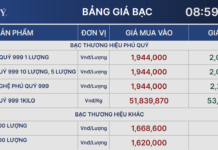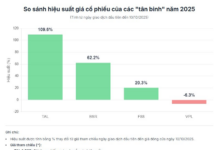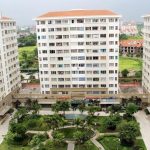Mr. Diep noted that the real estate market has recently experienced a lull. While the upcoming enforcement of the Land Law, Housing Law, and Business Law is expected to untangle many knots in the market, he believes that several bottlenecks remain.
The most significant bottleneck is the lack of synchronization in mechanisms and policies, resulting in a mismatch between supply and demand. Project approvals are lagging, while the demand for housing is substantial. Consequently, housing prices have soared, and affordable housing has become scarce, making it challenging for low-income earners to achieve their dream of homeownership. Additionally, complex and prolonged legal procedures exacerbate the situation.

Thousands of abandoned relocation apartments in Hanoi.
According to the Vice President of the Hanoi Real Estate Club, the procedures for developing a real estate project can take up to 3, 5, or even 15 years. This legal bottleneck significantly hinders the growth of the real estate market.
“In a context where people are thirsty for affordable housing, thousands of relocation apartments remain vacant and unused, resulting in significant waste. This situation arises from the mechanism of building relocation houses, with many relocation areas located far from the city center, lacking amenities and public services, especially job opportunities for residents,” Mr. Diep explained.
He further added that this reduces the appeal of these areas and creates difficulties for residents in terms of commuting and daily life. Some relocation projects also face issues with construction quality, including the use of inferior materials, impractical designs, and substandard construction. These problems not only affect the safety of residents but also diminish the value of the apartments, making them less desirable for potential occupants.
The Vice President of the Hanoi Real Estate Club emphasized that to foster the development of the real estate market, synchronized mechanisms and policies are necessary, along with creating resources and benefits for businesses and citizens. For instance, despite their high prices, commercial houses can thrive if the right incentives are in place. Therefore, untangling policy bottlenecks and generating resources for the real estate market are of utmost importance.
According to the Association of Brokers, the phenomenon of vacant relocation houses is not uncommon, with at least 13,000 such cases in Hanoi and Ho Chi Minh City alone. Many relocation areas in large cities have very low occupancy rates, and some buildings are entirely unoccupied. These structures, built on a large scale and requiring investments of thousands of billion dong, are left unused or underutilized, leading to the deterioration of infrastructure and other facilities.
In Hanoi, the city reports 174 relocation housing areas in use, totaling over 14,200 apartments. Approximately 4,000 of these units are vacant. While some projects have seen residents move in, a significant portion of the commercial space remains unoccupied for years, with no tenants or utilization.
In Ho Chi Minh City, the Department of Construction’s statistics reveal nearly 9,000 vacant relocation apartments. Specifically, the Binh Khanh relocation area in Thu Duc City has over 5,300 unoccupied units, and the Vinh Loc B project in Binh Chanh District has more than 2,000 vacant apartments.
According to the Vietnam Real Estate Brokers Association, the primary reason for the abandonment of relocation houses is their location far from city centers and the lack of amenities, making it challenging for residents to commute and engage in daily activities. Many areas also lack basic infrastructure, such as schools, hospitals, and markets.
Construction quality issues are prevalent in some projects, including the use of inferior materials, impractical designs, and substandard construction. These problems not only affect the safety of residents but also diminish the value of the apartments, making them less desirable for potential occupants.
Removing Land Policy Bottlenecks, Creating New Resources for Development
The passing of the Land Law by the National Assembly has been well-received by society, with expectations that policy barriers and bottlenecks will be quickly dismantled and eliminated. This will effectively utilize land resources, contributing to the creation of new resources that will promote socio-economic development…


































